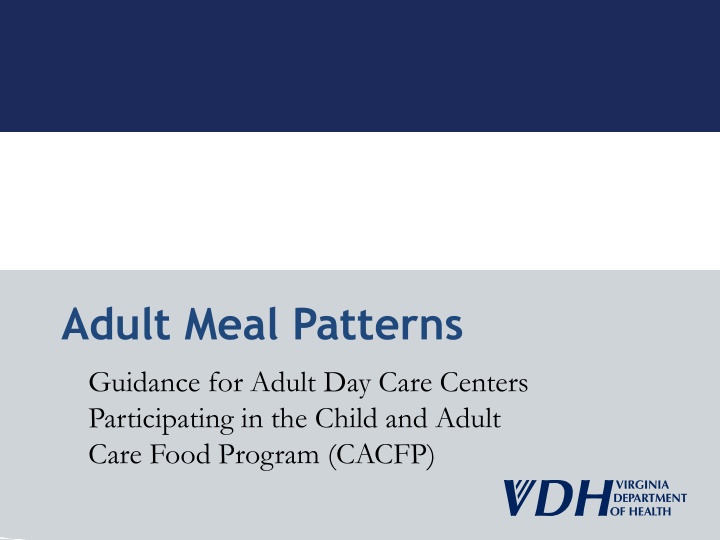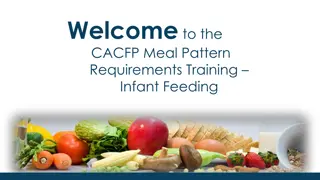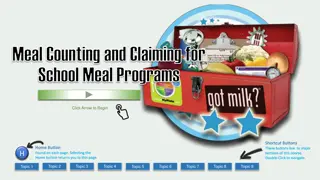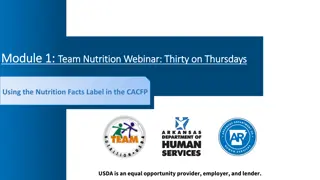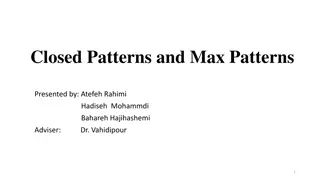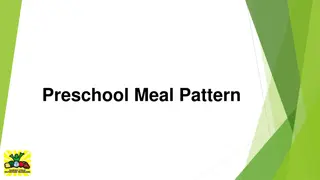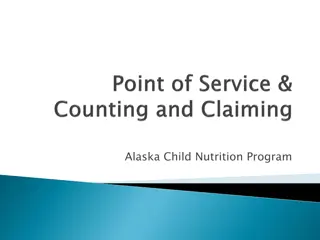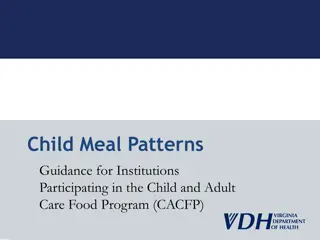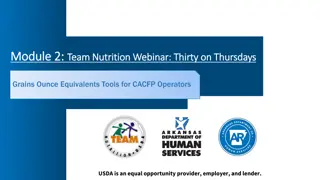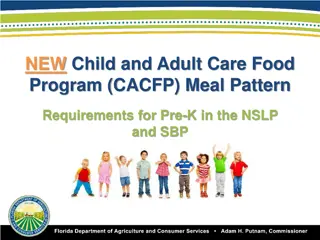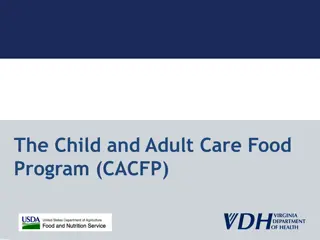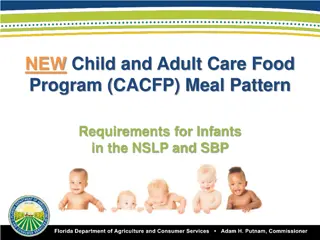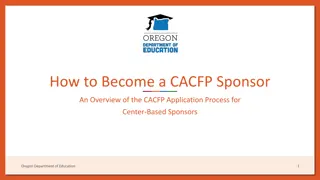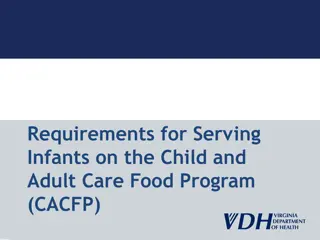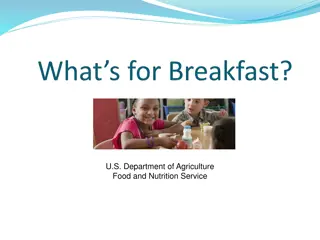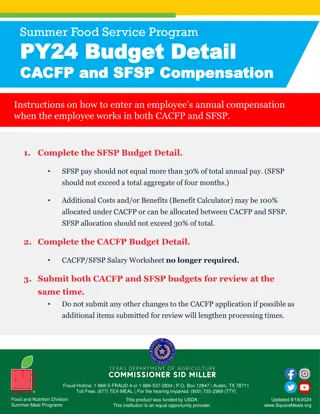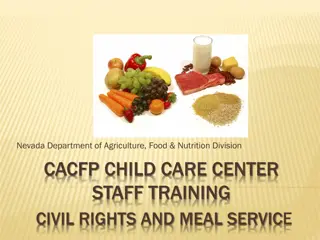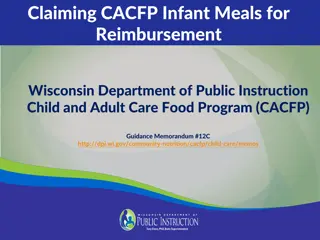Adult Day Care Meal Patterns Guidance for CACFP Participation
Providing well-balanced meals is crucial for adult day care centers participating in the CACFP. The meal pattern requirements ensure menus meet nutritional needs, align with Dietary Guidelines for Americans, and offer appetizing variety. Components for breakfast, lunch, supper, and snacks must be included for reimbursement. Planning menus that cycle every two months is essential for submitting fully reimbursable meal invoices.
Download Presentation

Please find below an Image/Link to download the presentation.
The content on the website is provided AS IS for your information and personal use only. It may not be sold, licensed, or shared on other websites without obtaining consent from the author.If you encounter any issues during the download, it is possible that the publisher has removed the file from their server.
You are allowed to download the files provided on this website for personal or commercial use, subject to the condition that they are used lawfully. All files are the property of their respective owners.
The content on the website is provided AS IS for your information and personal use only. It may not be sold, licensed, or shared on other websites without obtaining consent from the author.
E N D
Presentation Transcript
Adult Meal Patterns Guidance for Adult Day Care Centers Participating in the Child and Adult Care Food Program (CACFP)
Training Objectives Successfully determine whether a meal contains all of the meal pattern components requirements Develop two months worth of menus that include all of the CACFP meal pattern components and can be cycled throughout the year. Submit invoices for CACFP meals that are fully reimbursable
Meal Pattern Requirements CACFP meal pattern requirements assist the menu planner in providing well-balanced meals and snacks for participants that: Meet nutritional needs of participants Are consistent with the Dietary Guidelines for Americans Taste appetizing and contain a variety of food items (rotating foods)
Meal Pattern: Breakfast 3 Components Required for Reimbursement: Milk (1) Fluid milk Fruits/Vegetables (1) 100% fruit juice, fruit and/or vegetable Grain/Bread (1) Bread Cornbread, biscuit, roll, muffin Cold dry or hot cooked cereal Pasta, noodles, grains
Meal Pattern: Lunch ALL 5 Components Required for Reimbursement: Milk (1) Fluid milk Fruits/Vegetables (2) 100% fruit juice, fruit and/or vegetable Grain/Bread (1) Bread Cornbread, biscuit, roll, muffin Cold dry or hot cooked cereal Pasta, noodles, grains school-lunch1
Meal Pattern: Lunch ALL 5 Components Required for Reimbursement (cont): Meat/Meat Alternate (1) Meat, poultry, fish, or alternate protein product Cheese Egg Cooked dry beans or peas Peanut, other nut or seed butters, nuts and/or seeds Yogurt
Meal Pattern: Supper 5 Components Required for Reimbursement (cont): The same components are required for supper as are required for lunch except for milk. Adult Day Care is the only group in the CACFP for which milk is not required to claim supper.
Meal Pattern: Snack 2:4 Components Required for Reimbursement (cont): Milk (1) Fluid milk (low/nonfat for children over 2) Fruits/Vegetables (1) 100% fruit juice, fruit and/or vegetable Grain/Bread (1) Bread Cornbread, biscuit, roll, muffin Cold dry or hot cooked cereal Pasta, noodles, grains
Meal Pattern: Snack 2:4 Components Required for Reimbursement (cont): Meat/Meat Alternate (1) Meat, poultry, fish, or alternate protein product Cheese Egg Cooked dry beans or peas Peanut, other nut or seed butters, nuts and/or seeds Yogurt
Offer Versus Serve (OVS) At the discretion of the center, participants may be permitted to decline a certain number of food servings without the reimbursement for the meal being affected. Must notify VDH of intent to utilize offer versus serve Must offer additional components Not available for snacks
OVS Meal Pattern: Breakfast 4 servings must be offered: 1 serving of milk 1 serving of fruits/vegetables; and 2 servings of bread/grains Participants may decline 1
OVS Meal Pattern: Lunch 6 servings must be offered: 1 serving of milk 2 serving of fruits/vegetables; and 2 servings of bread/grains 1 servings of meat/meat alternate Participants may decline 2
OVS Meal Pattern: Supper 5 servings must be offered: 2 servings of fruits/vegetables; and 2 servings of bread/grains 1 serving of meat/meat alternate Participants may decline 2
Family Style Meal Service Meals served in a family style setting where foods are placed on a table in serving dishes and participants serve themselves. Meals are able to be claimed so long as: The amount of food on table provides full required portions of each component for all participants and any supervisors Every participant is offered and encouraged to take full portion of each required meal component When a component is refused or full portion size is not taken, a supervisor actively encourages taking a full portion, or offers a 2nd helping
Required Meal Components Meat and Meat Alternates Beef, chicken, fish, ham, pork, turkey and eggs Cheese Dry beans and peas Peanut butter, almond, and other nut butters (**Caution: Allergies and Choking Hazard**) Walnuts, peanuts, almonds, soy nuts, other nuts, and seeds (**Caution: Allergies and Choking Hazard**) Yogurt Alternate Protein Product (APP)
Required Meal Components Vegetables and Fruits Mixtures (fruit salad, veg medley)=1 serving Mixed dishes with cup or more each different fruit/veg + meat/meat alternate=2 servings
Required Meal Components Fruit Juice Guidelines Must be full strength (100%) Must be pasteurized Should not be served as snack if fluid milk is the only other component being served During lunch/supper, no more than half of the vegetable/fruit component can be met with fruit juice
Required Meal Components Grains and Breads: Required component of all meals Must be made primarily of whole-grain, enriched or fortified flour or meal (first ingredient listed on package) Includes: Enriched breads, cereals, and pasta such as white bread and corn tortillas Whole Grain breads, cereals and pasta such as whole-wheat bread and ready-to-eat cereal
Required Meal Components Milk: Required component of all meals except supper. May be served as a component of snack when the other component is not juice Not considered a serving when used as an ingredient in cooked meals
Milk in the CACFP Allowable types: Low fat (1% or fat free) Lactose-reduced or lactose free, buttermilk or acidified milk Unflavored or flavored, including chocolate or strawberry Goat s milk (only if pasteurized) USDA-approved non-dairy milk substitutes products (e.g. some brands of soy milk) at the participant s request as long as it is nutritionally equivalent to cow s milk.
Milk in the CACFP: Exceptions Medical or Other Special Dietary Need If a participant cannot consume fluid milk due to medical or other special dietary needs (e.g. vegetarian), non-dairy beverages may be served in lieu of milk If the substitute is not nutritionally equivalent to milk (e.g. juice, water), a signed medical statement is required for the meal to be claimed.
Milk Served in the CACFP: Exceptions Disability If a disability directly affects a participant s ability to consume milk and a signed medical statement is on file, the facility must purchase and can claim alternatives that do not conform to the meal pattern. Statement must include: Participant s disability and why it restricts participant s diet Major life activity affected by the disability Food(s) to be omitted from the participant s diet; and Appropriate substitutions
Meal Components: Exceptions Special Dietary Needs If a participant has special dietary needs (e.g. vegetarian), substitutions may be requested by submitting a written statement that includes the medical condition or special dietary need, listing food to be omitted and substitutions. In order to receive credit for foods outside of the meal pattern requirements, a signed medical statement must be on file.
Meal Components: Exceptions Disability If a disability affects what kinds of foods a participant can consume (liquid and/or non-liquid) and a signed medical statement is on file, the facility must purchase and can claim alternatives that do not conform to the meal pattern. Statement must include: Disability and why it restricts child s diet Major life activity affected by the disability Food(s) to be omitted from the participant s diet; and Appropriate substitutions
Resource: Crediting handbook for the Child and Adult Care Food Program http://www.fns.usda.gov/sites/default/files/CACFP_cr editinghandbook.pdf
